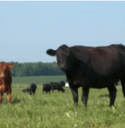Feeder Cattle Futures
 The world cattle population is well over 1 billion head, and in many cultures, such as in parts of Africa, having many cattle is a good signal of wealth. In order to be transferred to the feedlot and fattened for slaughter, feeder cattle must be between 1-2 years of age. The steer and cows that are chosen to become feeder cattle have usually been culled from a main herd because they are superfluous to breeding needs.
The world cattle population is well over 1 billion head, and in many cultures, such as in parts of Africa, having many cattle is a good signal of wealth. In order to be transferred to the feedlot and fattened for slaughter, feeder cattle must be between 1-2 years of age. The steer and cows that are chosen to become feeder cattle have usually been culled from a main herd because they are superfluous to breeding needs.
Feeder Cattle Contract Specifications
→ Click Here for Feeder Cattle Contract Specifications
Feeder Cattle Facts
Most feeder cattle are bred in the summer to ensure that their calves are born in the spring season because of both the temped climate and the abundance of pasture to feed on. Around 8 months of age, cattle are weaned from their mothers and sent to stocker operations in order to encourage growth to a substantial size (600-800 lbs.). After reaching this weight, feeder cattle are then sent to a feed lot where they are fed a certain diet to inhibit a quick weight gain. When feeder cattle mature to 1,200 lbs., they are sold to meat packers to be butchered. The U.S. exports over 2 billion pounds of beef every year.
Feeder cattle futures allow traders to be a part of an all-encompassing market that includes price demand for feed grain and the cattle themselves. It can also allow traders to address price risk among those involved in the trade of feeder cattle and to assess supply and demand of cattle, feed, and for both the current and future outlook.
Source: Barchart
Last updated October 2015.